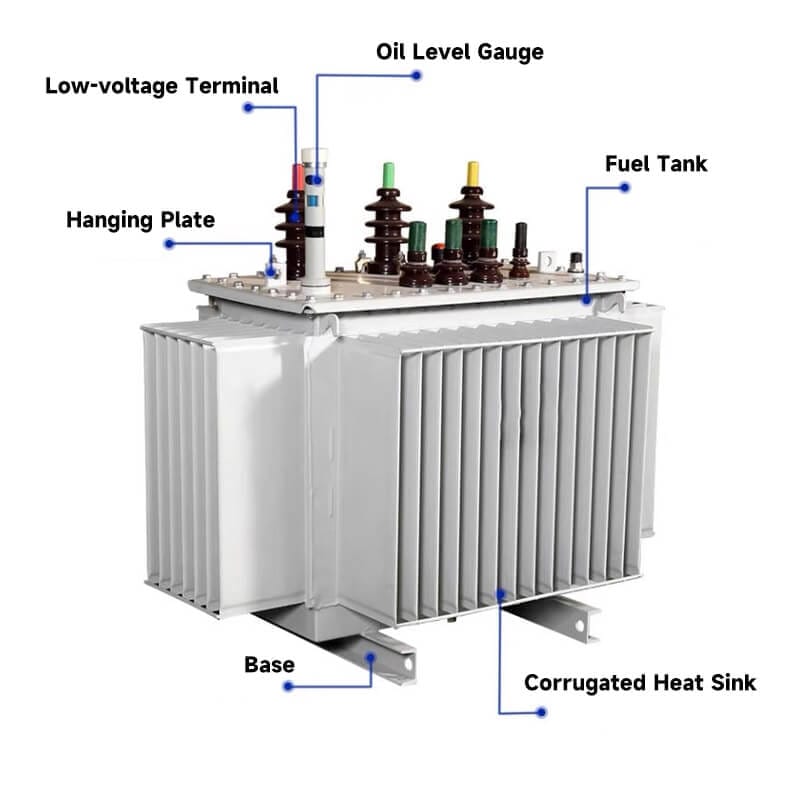Dry-type transformers and oil-immersed transformers differ significantly in structure, performance, and application scenarios; the specific differences are as follows:According to related reports, distribution transformer To a large extent, it leads the changes of market conditions. https://www.jslhtf.com/
difference between dry and oil type transformer
Structural Comparison
Item
Dry-type Transformer
Oil-immersed Transformer
Insulation Materials
Solid insulation materials such as air, epoxy resin casting, and vacuum pressure impregnation (VPI)
Transformer oil (mineral oil or synthetic ester oil, which serves both insulation and cooling functions)
Cooling Method
Natural air cooling (AN) or forced air cooling (AF)
Oil circulation heat dissipation (e.g., natural oil cooling ONAN, forced oil circulation air cooling OFAF)
Windings
Copper/aluminum windings with outer layers wrapped in epoxy resin or Nomex paper, featuring high protection levels
Copper/aluminum windings directly immersed in insulating oil
Enclosure & Accessories
Typically IP20 protection level; optional dustproof and waterproof enclosures (e.g., IP54)
Sealed oil tank, equipped with accessories such as oil conservators (oil pillows), pressure relief valves, and oil level gauges
Differences in Working Principles
Common principle: Both are based on electromagnetic induction, achieving voltage transformation through the turn ratio of windings.
Core differences:
Heat dissipation: Dry-type transformers rely on air convection or forced air cooling; oil-immersed transformers transfer heat to radiators/coolers via oil circulation.
Insulation: Dry-type transformers depend on solid material insulation; oil-immersed transformers utilize the high insulation and heat capacity of liquid oil.
industrial transformer manufacturers? (3)
Comparison of Performance Characteristics
Characteristic
Dry-type Transformer
Oil-immersed Transformer
Safety
Oil-free, no fire or leakage risks; suitable for places with high fire protection requirements
Oil is flammable, requiring additional fire prevention measures; risk of oil leakage pollution exists
Heat Dissipation Capacity
Poor; capacity usually + 2500kVA
Excellent; capacity can reach hundreds of MVA, suitable for high-load scenarios
Environmental Friendliness
No hidden danger of oil leakage; more environmentally friendly
Requires waste oil disposal; risk of leakage pollution
Volume & Weight
Smaller volume and lighter weight (no need for oil tanks or oil circulation devices)
Larger volume and heavier weight (including oil tanks, radiators, etc.)
Noise Level
Lower (no noise from oil circulation equipment)
Higher (noise generated by operating oil pumps and fans)
Maintenance Cost
Maintenance-free or low maintenance (no need for oil replacement or oil quality inspection)
Requires regular oil quality and level inspections; complex maintenance
Application Scenarios
Dry-type Transformers
Oil-immersed Transformers
Indoor scenarios: high-rise buildings, subways, hospitals, data centers (high fire protection requirements)
Large-capacity scenarios: main transformers in substations, industrial parks (e.g., steel, chemical industries)
Special environments: humid, dusty environments (adaptable with IP54 protection)
Outdoor applications: power grid transmission/distribution lines, power plant step-up stations
Distributed energy: wind farms, photovoltaic power stations (medium and low-voltage distribution sides)
High-temperature environments: scenarios requiring long-term high-load operation (oil has high heat dissipation efficiency)
types of distribution transformer
Summary of Advantages and Disadvantages
Type
Advantages
Disadvantages
Dry-type Transformer
Safe and environmentally friendly (oil-free), maintenance-free, flexible installation, low noise
Limited capacity, high cost, poor heat dissipation, shorter service life
Oil-immersed Transformer
Large capacity, low cost, good heat dissipation, long service life
Fire risk exists, complex maintenance, large volume, poor environmental friendliness (oil leakage/waste oil)
Selection Suggestions
Choose dry-type transformers for scenarios with high fire protection requirements (e.g., urban centers, hospitals), limited space, or high environmental sensitivity.
Choose oil-immersed transformers for scenarios with large capacity requirements (e.g., industrial zones), outdoor installation, or cost sensitivity (e.g., rural power grids).